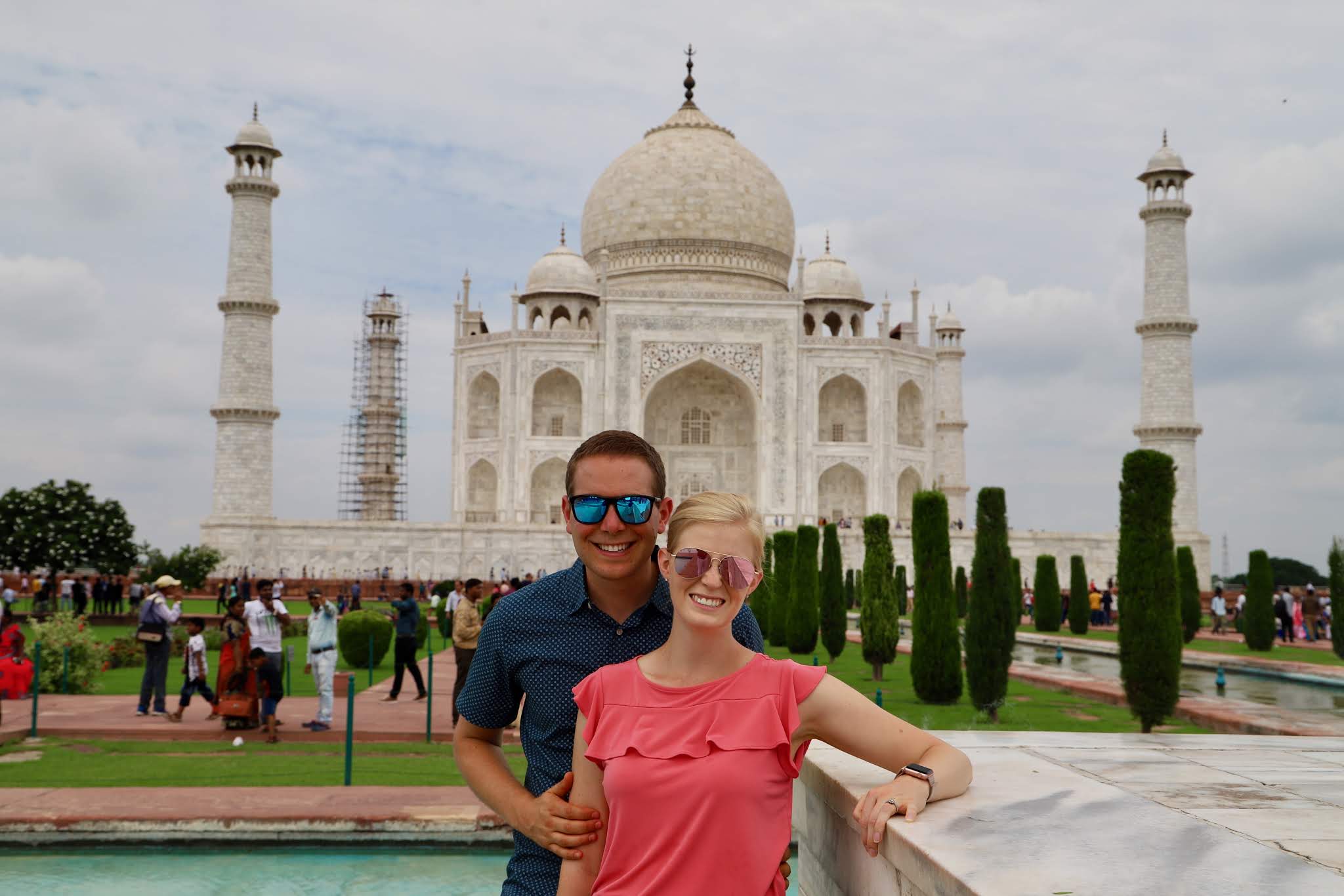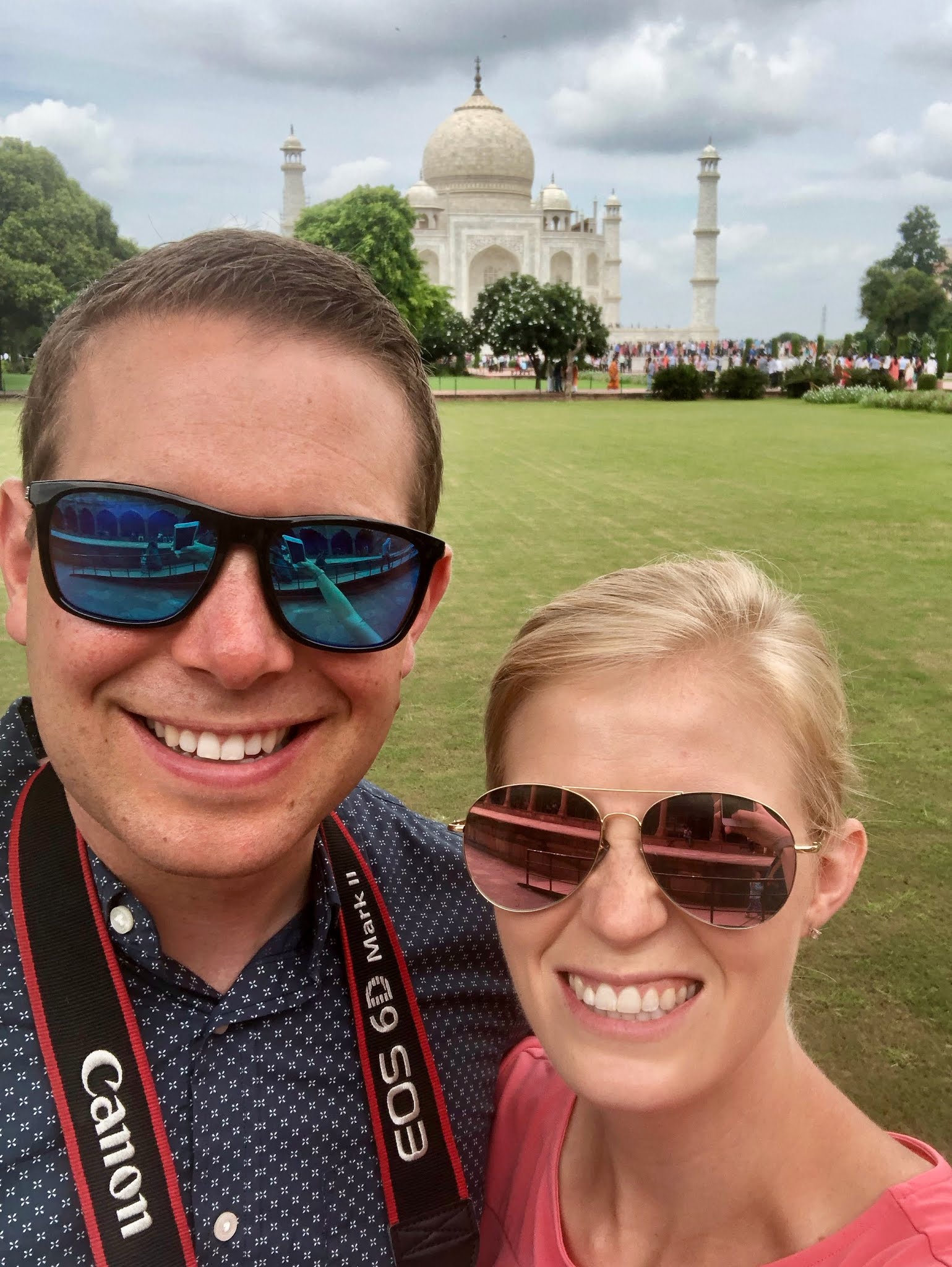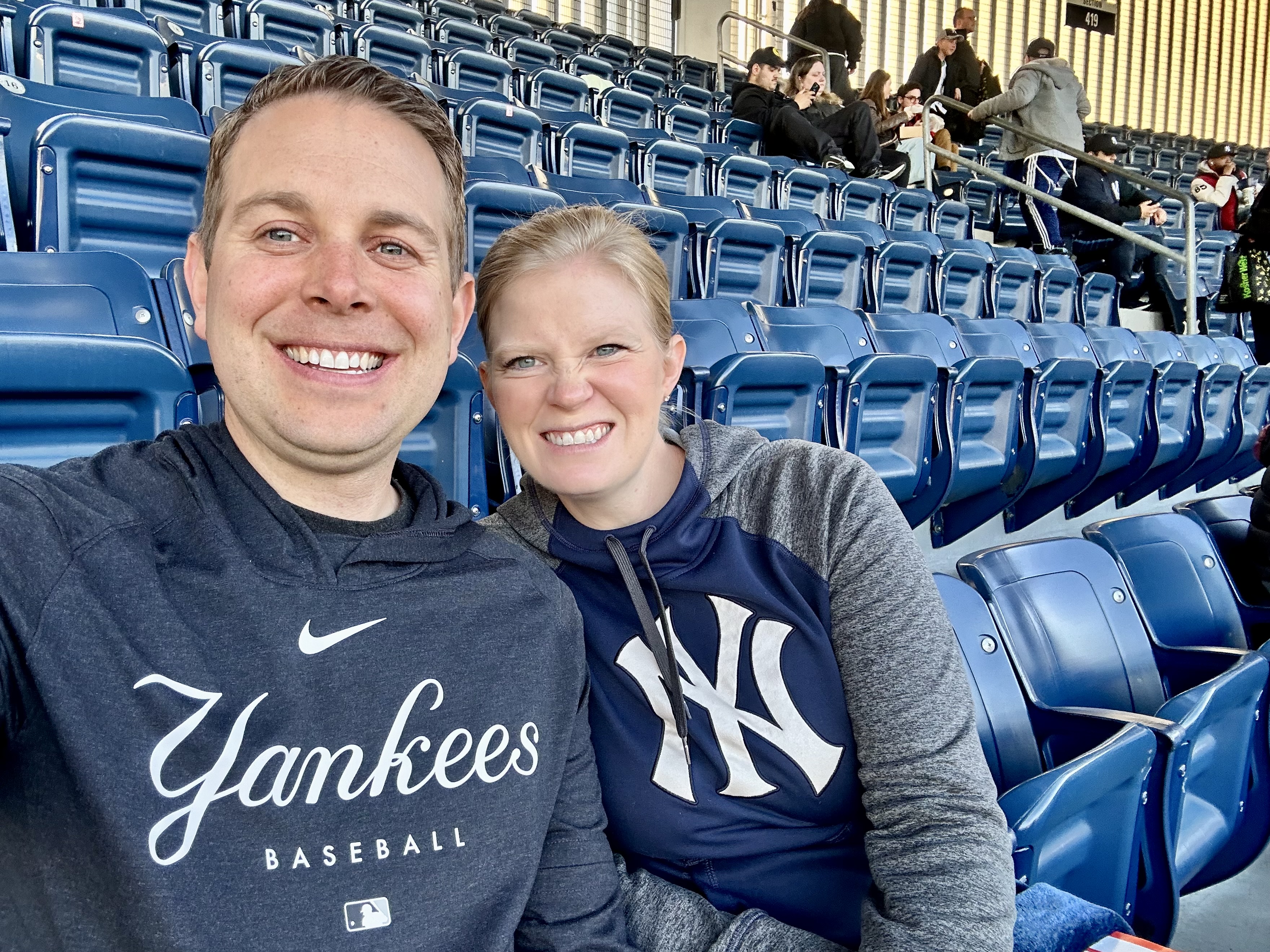Day 10 – Taj Mahal
Today was the best day in India! We woke up at 5:00 AM so we could be at the Taj at 6:00 for sunrise. The Taj Mahal is beyond description – it is beautifully built and immaculately maintained. We entered the complex and came upon the gate to enter. Shah Jahan, the fifth Mughal emperor, built the Taj Mahal for his wife whom he loved dearly. Because the tomb was built for a woman, the gate acts as a type of “veil” since Muslim women were always behind a curtain at that time.
The gate itself was beautiful. Shah Jahan spared no expense in building the Taj Mahal complex. The entire tomb is made of white marble and the gate is made of red sandstone and white marble. The flowers and calligraphy are all stones that are in-laid in the marble. It took 20,000 workers 22 years to finish the construction of the entire Taj Mahal Complex.
We then entered the complex and it took our breaths away. The symmetry is amazing. Mughal gardens were always divided into four equal gardens representing water, milk, wine, and honey. The Taj Mahal further divides the gardens into four more equal gardens. Fountains are running throughout the gardens. We spent a lot of time walking around the gardens before ascending the white marble pedestal.
From a distance, the Taj Mahal looks completely white, but up close it’s easy to see the flowers, calligraphy, and motifs that decorate the complex. There are in-laid stone flowers throughout the white marble in addition to verses from the Koran. The relief sculpture flowers were meant to be quite exotic. Around the bottom of the dome, there are upside-down lilies to represent mourning. When the light hits the white marble, the stones start to glisten and light up, so the colors change with the sun. It’s quite spectacular.
Next to the Taj Mahal sits a mosque and a Guest House. Because this is a Muslim monument, guests previously had to remove their shoes, however, now the monument provides shoe covers. We did, however, have to take off our shoes to enter the Mosque. The Mosque had beautiful architecture and design work throughout. The Indo-Islamic architecture of India is truly stunning.
We entered the mausoleum and the interior decorations were stunning. There are see-through panels made out of a single stone of white marble surrounding the tombs of Shah Jaran and his wife. There are also very fine flowers laid into the marble throughout – these would have taken years to create because each of the individual pieces is so tiny. The only part of the Taj Mahal that is not completely symmetrical is the burial sites. Shah Jaran buried his wife exactly in the middle of the tomb. When he died, he was laid to rest beside her, but because she was in the middle the graves were not symmetrical.
Our guide commented several times throughout the tour that this was the only monument dedicated to love in the world. Eric and I later discussed that we have seen many tombs built during our world travels in Egypt, Jordan, and China. However, most tombs were built by Kings or Emperors for themselves. The Taj Mahal was built for the Emperor’s wife who died in childbirth with their 14th child. They were true lovers and they wanted to remain together even after this life. It’s really quite beautiful.
After exiting the mausoleum, Eric and I continued wandering around enjoying the monument. This is the fifth wonder of the modern world that we have visited and we were struck by how well-maintained it is. Every other wonder that we have visited is still amazing and beautiful, but far from its original condition. The Taj Mahal looks like it was built yesterday. The colors of the stones haven’t faded, been discolored by the sun, or been vandalized. It’s been well-preserved and maintained. It’s a testament to the workmanship of the monument.
 |
| Do you see the monkey? |
We returned back to the hotel for breakfast and to pack our bags and then we headed to the Agra Fort. The Third Mughal emperor, Akhbar built this Fort in the sixteenth century. It was also occupied by his son, Jahangir, and Shah Jahan who built the Taj Mahal. The early sections were red sandstone. Throughout the palace, there were beautifully carved columns and ornate brackets to support the ceiling. The artistry was incredible.
 |
| View of the Taj Mahal from our hotel room |
Shah Jahan expanded the palace and built several sections in white marble for his wife and two of his daughters. The workmanship was similar to the Taj Mahal (which can be seen from the Fort – although it was built later). There were many stone flowers in-laid within the white marble. It was truly a palace built for a King and Queen.
 |
| This parakeet was hanging out in this hole created by a British cannon ball. This is one of the reminders of British rule in India. |
Once we finished the Fort we only had one thing left on the agenda before heading back to the airport. Our flight out isn’t until midnight and although we had a 4-hour drive back to Delhi, this would still put us at the airport 7-8 hours before our flight. I’ve never been one who enjoyed spending a lot of time at airports, so I asked if we could go back to the Taj Mahal because I would rather spend time there than sitting at the airport. Our guide was happy to oblige.
Seeing the Taj in the midday sun was beautiful. Our guide took a million pictures of us (photography is one of his hobbies) and we enjoyed spending about 90 more minutes in the presence of this gorgeous monument. We were both so happy. I commented that even if we could have spent the entire day there, it would never be enough time. It’s such a gorgeous building and I felt such a strong connection to it.
One of my favorite things to learn about in college was art history. I took 3 art history classes while I was at BYU and absolutely loved every one of them. It didn’t occur to me until much later that each of those classes focused almost exclusively on European Art. I’ve always loved Renaissance art. The symmetry and balance speak to me and calm my soul. I always thought the Italian Renaissance artists were such geniuses because they figured out balance and symmetry. Although they were geniuses, other artists and craftsmen in other parts of the world were figuring out similar art forms that also included balance and symmetry. Indo-Islamic art speaks to me in the same way that Renaissance art does.
During this trip, I thought a lot about why I only learned about European art in my classes. The classes were meant to be general art history classes, not specific to Europe. I suppose that because class time was limited the professors and textbook writers focus on what students can most easily relate to. Since most students in America are of European descent, they focus on European art. It’s really quite sad though. World history should truly be a history of the world. And Art history should be art throughout the world. Asia has so much beautiful art.
Our final stop after the Taj Mahal was a cooking demonstration. We went to an Indian home where a woman named Kalyani lived with her husband, her brother, and her mother who turned 78 today. Kalyani explained signature spices which are cumin, mustard, anise, and black pepper. There are other signature spices as well including onions, garlic, and tomatoes. Signature spices are used to enhance the flavor of food and are based on individual preferences. There are also essential spices in Indian cooking which include Coriander, Turmeric, and chili powder. These spices go into everything.
Kalyani heated up a pan and began heating oil. She explained that she mostly cooks with mustard seed oil, but the smell can be overwhelming to tourists so she used rice oil instead. Once the oil was hot, she added cumin seeds, which began popping and releasing the fragrance. She then added boiled potatoes and added spices. She didn’t measure the spices – she just had a small spoon that she used to put the spices into the potatoes. It was a work of beauty. She mixed it all together – added green chilies and cilantro, and then let it sit on the stove.
She then showed us how to make roti. She explained that Indians eat bread with every meal, and roti is the meal primarily made at home. They combined whole-wheat flour with salt and water and mixed it by hand until it didn’t stick to either the bowl or their hands. Then they dipped it in flour so it wasn’t sticky and rolled it into almost a tortilla shape. They then placed it in a special pan and cooked it for about 20 seconds on each side. They then remove the pan and place the roti directly on the gas burner. The roti puffs up and then it’s done.
Kalyani also explained that food that is eaten at home is very different than the food we have been eating in restaurants. Restaurant food focuses on gravies, thick sauces, and naan bread. At home, the meals consist of lentils, a vegetable, bread, and rice. Rice is more popular in Southern India and bread is more popular in Northern India. Roti is cooked at home instead of naan bread because it’s made of wheat flour instead of refined flour and can be cooked on a stove instead of a clay oven. They then served us lunch consisting of lentils, zucchini, pumpkin, potatoes, rice, and roti bread. It was truly delicious and it was fun eating typical “home” food.
With that – it was time to say goodbye to India. We drove 4 hours back to Delhi.
As we are leaving India, I wanted to capture a few of my thoughts. The country is beautiful. I’m so glad that we had the opportunity to visit and I can’t wait to come back to India and explore even more someday! I would also highly recommend India for other people to visit. That being said – there were a few absolutely heartbreaking things. First, the poverty that we saw throughout India and Nepal was really hard. In Nepal, school is not compulsory so only 65% of the country is literate. In India, school is compulsory but that’s a fairly recent development so there are still a lot of areas of the country that are illiterate. Agra is a very poor area of India and only 48% of women in Agra are literate. That makes me so sad and makes it seem like our problems are so small in comparison. It also makes me incredibly grateful for all the opportunities that I have as an American.
Second – all of our guides and drivers were great. They treated Eric and me so well. However, when I saw the poverty in several of the places, it made me feel guilty. They put their best foot forward and are so wonderfully hospitable. However, it’s hard to think that just outside my luxurious hotel there are people who are barely making it. It makes me want to do more to help those around me. Eric and I did make it a point to be extremely generous with tips and with our shopping. They need the money more than we do.
Third – the condition of many of the animals here was heartbreaking. I’ve never seen so many stray dogs in my life. Hindu people are wonderful and they all take care of the animals. However, it was still hard to see dogs wandering everywhere. I was always worried we were going to hit one in our car. There were also a lot of cows wandering about – especially in Agra (although we saw it in Delhi and Jaipur as well). Many people will keep cows or water buffalo at home for milk. However, when the cows no longer produce milk, they will turn them loose and the entire community will feed them. Unfortunately, we saw some of the worst parts of animal tourism as well. The Elephant Riding in Jaipur can only be described as inhumane. Additionally, there were horse carriages near the entrance to the Taj Mahal that made me want to cry. We need to do more when thinking about animal tourism. It’s our duty to be responsible and ensure that we absolutely know that the animals are being treated well and that it’s within their nature when considering animal tourism (this is rarely the case).
Finally – I’ve thought a lot about religion on this trip. This was our first major encounter with the Hindu religion and I thought it was such a beautiful religion. It’s very open and there is very little judgment as to when, how, and who they worship. India has basically always been secular because Hindus see value in other religions (and in many cases even adopt parts of other religions into their own). This is such a stark difference between the monotheistic religions. It feels much kinder. Eric and I were so impressed by the kindness of everyone that we met in India. I think a large part of this comes from the openness of their religion. It’s so beautiful.


















































































Hey Blogger,
ReplyDeleteThanks for the Amazing Article. As you know, the Golden Triangle Tour is the main tour of India. So, this blog is very helpful for me.
Experience Golden Triangle Tour with Ranthambore Tiger Safari, that is really helpful to make an exciting memory. if you are interested so please visit us. https://www.classictoursindia.com/golden-triangle-tour-with-ranthambore.php
Thank you...
Classic Tours India